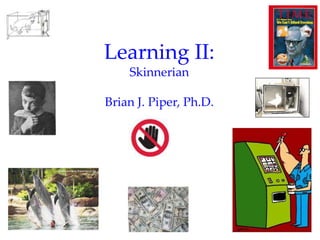
Introductory Psychology: Learning Part II (Operant)
- 1. Learning II: Skinnerian Brian J. Piper, Ph.D. 1
- 2. Operant Conditioning Burrhus Frederic Skinner 1904-1990 Skinner’s Experiments Extending Skinner’s Understanding Skinner’s Legacy Contrasting Classical & Operant Conditioning
- 3. Operant & Classical Conditioning 1. Classical conditioning forms associations between stimuli (CS and US). Operant conditioning, on the other hand, forms an association between behaviors and the resulting events.
- 4. Operant & Classical Conditioning 2. Classical conditioning involves respondent behavior that occurs as an automatic response to a certain stimulus. Operant conditioning involves operant behavior, a behavior that operates on the environment, producing rewarding or punishing stimuli.
- 5. Thorndike’s Experiments 1874-1949 Edward Thorndike discovered the law of effect. This law states that rewarded behavior is likely to occur again. Yale University Library
- 6. Operant Chamber Using Thorndike's law of effect as a starting point, Skinner developed the Operant chamber, or the Skinner box, to study operant conditioning. Edition by Michael P. Domjan, 2005. Used with permission From The Essentials of Conditioning and Learning, 3rd by Thomson Learning, Wadsworth Division Walter Dawn/ Photo Researchers, Inc.
- 7. Operant Chamber The operant chamber, or Skinner box, comes with a bar or key that an animal manipulates to obtain a reinforcer like food or water. The bar or key is connected to devices that record the animal’s response.
- 8. Shaping Lever Pressing Behavior • simply turning toward the lever will be reinforced • only stepping toward the lever will be reinforced • only moving to within a specified distance from the lever will be reinforced • only touching the lever with any part of the body, such as the nose, will be reinforced • only touching the lever with a specified paw will be reinforced • only depressing the lever partially with the specified paw will be reinforced • only depressing the lever completely with the specified paw will be reinforced
- 9. Shaping Shaping is the operant conditioning procedure in which reinforcers guide behavior towards the desired target behavior through successive approximations. 10 min: http://www.youtube.com/watch?v=NhmZBMuZ6vE
- 10. Types of Reinforcers Reinforcement: Any event that strengthens the behavior it follows.
- 11. Primary & Secondary Reinforcers 1. Primary Reinforcer: An innately reinforcing stimulus like food or drink. 2. Secondary Reinforcer: A learned reinforcer that gets its reinforcing power through association with the primary reinforcer.
- 12. Immediate & Delayed Reinforcers 1. Immediate Reinforcer: A reinforcer that occurs instantly after a behavior. A rat gets a food pellet for a bar press. 2. Delayed Reinforcer: A reinforcer that is delayed in time for a certain behavior. A paycheck that comes at the end of a week. We may be inclined to engage in small immediate reinforcers (watching TV) rather than large delayed reinforcers (getting an A in a course) which require consistent study.
- 13. Reinforcement Schedules 1. Continuous Reinforcement: Reinforces the desired response each time it occurs. 2. Partial Reinforcement: Reinforces a response only part of the time. Though this results in slower acquisition in the beginning, it shows greater resistance to extinction later on.
- 14. Ratio Schedules 1. Fixed-ratio schedule: Reinforces a response only after a specified number of responses. e.g., piecework pay. 2. Variable-ratio schedule: Reinforces a response after an unpredictable number of responses. This is hard to extinguish because of the unpredictability (e.g., behaviors like gambling, fishing).
- 15. Interval Schedules 1. Fixed-interval schedule: Reinforces a response only after a specified time has elapsed. (e.g., preparing for an exam only when the exam draws close.) 2. Variable-interval schedule: Reinforces a response at unpredictable time intervals, which produces slow, steady responses. (e.g., pop quiz.)
- 17. Applications of Operant Conditioning Skinner introduced the concept of teaching machines that shape learning in small steps and provide immediate reinforcements for correct responses. They also provide individualized instruction. Skinner (1958). Science, 128, 969-977. In School LWA-JDL/ Corbis
- 18. Applications of Operant Conditioning • Animal training • Applied Behavior Analysis: – Worth video Sampler: 2004 Abnormal Psychology
- 19. Punishment Any event that decreases the behavior it follows.
- 20. Punishment Although there may be some justification for occasional punishment, it usually leads to negative effects. 1. Results in unwanted fears. 2. Conveys no information to the organism. 3. Causes unwanted behaviors to reappear in its absence 4. Justifies pain to others. 5. Causes aggression towards the agent.
- 21. Biological Predisposition Biological constraints predispose organisms to learn associations that are naturally adaptive. Breland and Breland (1961) showed that animals drift towards Photo: Bob Bailey their biologically predisposed instinctive behaviors. Marian Breland Bailey
- 22. Latent Learning Tolman & Honzik (1930) University of California Publications in Psychology, 4, 257-275.
- 23. Latent Learning Tolman & Honzik (1930) University of California Publications in Psychology, 4, 257-275.
- 24. Skinner’s Legacy Skinner argued that behaviors were shaped by external influences instead of inner thoughts and feelings.
- 25. Most “Eminent” Psychologist of 20th Century • Eminence was defined based on: – journal citation frequency – textbook citation frequency – survey of professional society (APS) – Membership in National Academy of Sciences Haggbloom et al. (2002). Review of General Psychology, 6, 139-159.
- 26. Most “Eminent” Psychologists of 20th Century
- 27. History of Behaviorism Key Quote (1930) “Give me a dozen healthy infants, well-formed, and my own specified world to bring them up in and I'll guarantee to take any one at random and train him to become any type of specialist I might select – doctor, lawyer, artist, merchant-chief and, yes, even beggar-man and thief, regardless of his talents, penchants, tendencies, abilities, vocations, and race of his ancestors. I am going beyond my facts and I admit it, but so have the advocates of the contrary and they have been doing it for many thousands of years.” 27
- 28. Originator Ivan Pavlov Fred Skinner
